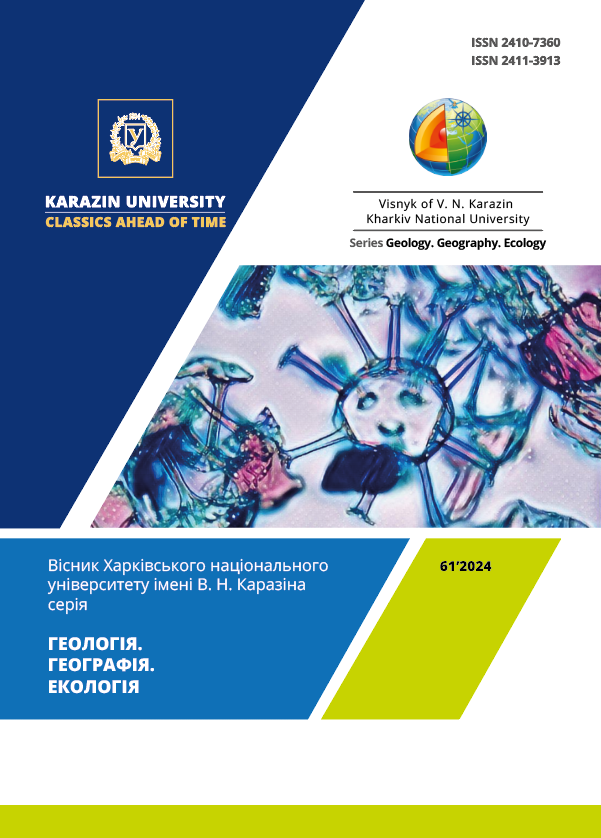The Paleogeographic Conditions for the Late Eocene sediments of Zhytomyr Polissya in connection with their amber content (on the example of the «Pravoberezhnа» site)
Abstract
Problems Statement and Purpose. The work is relevant because of the need to create a reliable history of the formation of the physical and geographical environment of the Paleogene in the territory of Zhytomyr Polissya to decipher the processes of amber accumulation. In accordance with the mineragenic zoning, the territory of the amber-bearing site "Pravoberezhna" is located within the Perha amber-bearing region. The latter is located within the Volyn-Podilskyi plutonic belt and is separated from the adjacent regions by the Hlynnensky and Sushchan-Perha tectonic zones. The main difference between the Klesiv-Rokytnyansky, Sloveschansky-Ovrutsky and Barashiv-Perha amber-bearing zones is the different age of the amber-bearing rocks.
Data and Methods. A comprehensive lithological-micropaleontological and palynofacial analysis of amber-bearing deposits of the «Pravoberezhna» site of the Perha amber-bearing district of Zhytomyr Polissya was conducted. 38 sections exposing Paleogene deposits have been described.
Results and Discussion. The age of the host rocks was reinterpreted based on dinocysts. For the first time in this territory, the dating of amber deposits to the Late Eocene interval was proven. The Obukhiv sediments, isolated from the Paleogene sequence, are characterized by a complex of dinocysts from Rhombodinium perforatum, Thalassiphora reticulata, Charlesdowniea clathrata angulosa, Glaphyrocysta semitecta, etc. zone DP11 of the biozonal scheme of A.S. Andreeva-Grigorovich (1991). The granulometric and material composition of the Obukhivian sediments was studied. A model scheme shows the change in the occurrence of sediments of the Obukhiv regiostage according to the evolution of ancient tectonic valleys. New data about the Obukhiv marine palynological association within the «Pravoberezhna» site which contributes to the little-studied area of marine environments of the Late Eocene of Northern Ukraine was presented. Palynobiota includes representatives of Dinoflagellata, Prasynophyta, Acritarcha, pollen and spores of terrestrial plants, as well as transparent and opaque phytoclasts, fungal palynomorphs, «palynoforaminifera», scolecodonts. Palynofacies analysis shows that the sediments containing amber deposits within the «Pravoberezhna» site were formed by a shallow warm sea with high hydrodynamics under the high influence of river systems. It was found that the largest accumulations of amber are probably associated with paleodelta facies.
Downloads
References
Atlas of Paleogene Dinocysts of Ukraine, Russia and adjacent countries (2011). Andrejeva-Grigorovich A.S., Zaporozhets N.I., Shevchenko T.V. et al. Naukova Dumka, Kyiv: 224.
Bogdasarov M.A., Komlev A.A., Krynytska M.V., Nesterovski V.A., Petrov N.P. (2014). The Geological Genetic Model of Amber-Bearing Deposits of Belarus and Ukraine. Scientific Proceeding оf Brest University Collection of scientific works Issue 10 Part 2 Natural Sciences Brest: 98-109.
Zosimovich V.Yu., Shevchenko T.V. (2014). Development stages of Paleogene sedimentary basins of Northern Ukraine. Collection of scientific works of the Institute of Geological sciences NAS of Ukraine. 7: 83-100. DOI: https://doi.org/10.30836/igs.2522-9753.2014.146855 [in Ukrainian].
Zosimovich V.Yu., Shevchenko T.V. (2015). Paleogene deposits of the Northern Ukraine paleosedimentary province. Collection of scientific works of the Institute of Geological sciences NAS of Ukraine. 8: 68-121. DOI: https://doi.org/10.30836/igs.2522-9753.2015.146712 [in Ukrainian].
Krynytska M.V., Shpyrka V.M. (2008). Territorial zoning of amber-bearing areas of Ukraine in the light of their hierarchical subordination. Ukrainian Amber World: abstracts of the reports of the Second international conference of October 16-17, 2008. Kyiv: 12-13. [in Ukrainian]
Mazur M.D., Bila T.O., Drozdetsky V.V. et al. (2010). Geologic building and mineral deposits of the head of river Ubort. Report on geologic additional investigation on the territory of M-35-X (Olevsk) sheet, scale 1:200 000. Kyiv, 1, 281. 4, 259. PDRGP «Pivnichgeologiya». Rivne GE. Fund of the State Enterprise «Ukrainian Geological Company».
Mamchur S. (2023). To reasoning allotment Perzhanskiy amber area. Materials to XIII all-Ukrainian youth scientific conference-school «Modern problems of Earth Sciences». Kyiv: 16-18. [in Ukrainian].
Makarenko D.E. (1958). To the stratigraphy of the Paleogene deposits of Olevsky district, Zhytomyr region. Reports of the Academy of Sciences of Ukraine of the Ukrainian SSR, 4: 59-61. [in Ukrainian].
Makarenko D.Ye. (1959). Paleogene deposits of the northwestern part of the Ukrainian shield, Geological Journal, 19(1): 47-56. [in Ukrainian].
Matsui V.М., Nesterovskij V.А. (1995). Amber of Ukraine (state of the problem). Kiev: MP «Terra»: 56.
Melnychuk V.G., Krynytska M.V. (2018). Amber of Polissya. Handbook Rivne: NUVGP: 236 [in Ukrainian].
Naumenko U., Matsui V. (2020). Map of fossil resins of Ukraine. Mineral resources of Ukraine. 4: 13-17. DOI: https://doi.org/10.31996/mru.2020.4.13-17 [in Ukrainian].
Stratigraphic schemes of the Phanerozoic formations of Ukraine for geological maps the new generation (1993). Graphic applications. Tables. Kyiv.
Stratigraphy of the USSR. 9. Paleogene (1963). Kyiv: 319. [in Ukrainian].
Shevchenko T.V., Kurepa Ya.S., Ryabokon T.S., Mamchur S.V., Zosymovych V.Yu. (2021). Eocene and Oligocene marine sediments of the Ukrainian Polissia: new micropaleontological data. Evolution of organic world as fundament of stratigraphy and correlation of Phanerozoic of Ukraine: Materials of International scientific conference and XL session of the Ukrainian Paleontological Society of NAS of Ukraine, dedicated to a memory of the Academician of NAS of Ukraine Petro Feodosiiovych Gozhyk (Kyiv, November 10–12, 2021). Кyiv: 64-65. [in Ukrainian].
Shevchenko T.V., Kurepa Ya.S., Ryabokon T.S., Zosimovich V.Yu. (2021). New data on Middle-Upper Eocene stratigraphy of the north-western area of the Ukrainian shield. Geographical aspects of sustainable development of regions: Materials of the IV International Scientific and Practical Conference. Gomel: 275-279. [in Ukrainian].
Yakovleva V.V., Panchenko V.P. (2004). Amber of Western Polesie and other regions of Ukraine. Priroda Zahidnogo Polissya ta prileglih teritorij: Zb. nauk. pr. Lutsk: 23-32. [in Ukrainian].
Gedl P. (2013). Eocene dinoflagellate cysts from the Popiele beds at Koniusza (Skole Nappe, Flysch Carpathians, Poland): taxonomy, biostratigraphy, and palaeoenvironmental reconstruction of a marginal marine basin. Studia Geologica Polonica. 135: 197.
Mendonça Filho J.G., Menezes T.R., Mendonca J.O. et al. (2012). Organic Facies: Palynofacies and Organic Geochemistry Approaches Geochemistry. Geochemistry. Earth and System Processes. 1: 211-245.
Palcu D.V., Krijgsman W. (2021). The dire straits of Paratethys: gateways to the anoxic giant of Eurasia. Geological Society Special Publication. 523: 111-139 DOI: https://doi.org/10.1144/SP523-2021-73





